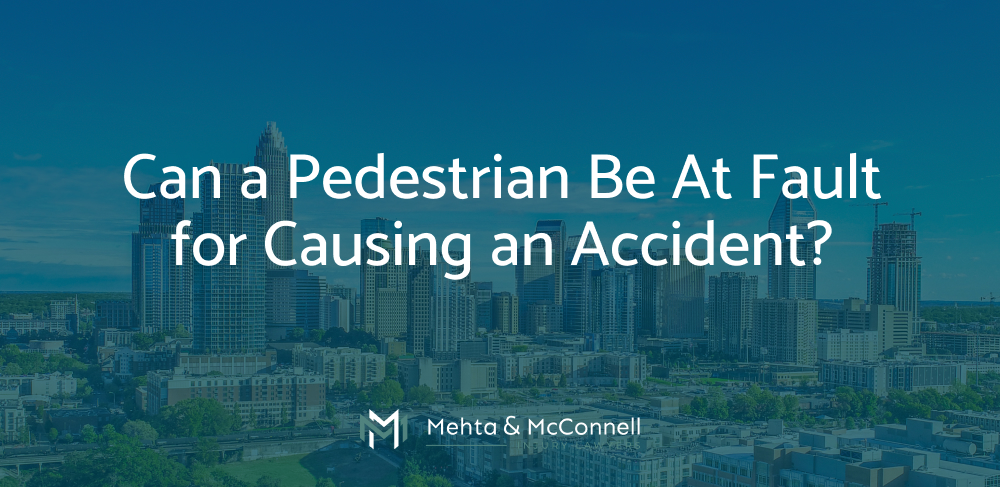
When a vehicle hits a pedestrian, you might assume the driver was at fault. But can a pedestrian be at fault for causing a car accident?
Yes, a pedestrian can be at fault, especially if they violate the rules of the roadway. Whether any individual is at fault depends on the unique circumstances of each case.
At Mehta & McConnell, PLLC, we represent injured drivers, passengers, and pedestrians alike.
Our history defending corporations and insurance companies gives us an edge when you need to take them on. We’re passionate about fighting to get you the compensation you deserve.
Rights and Duties of Pedestrians
A portion of North Carolina’s motor vehicle code is dedicated to what pedestrians can and cannot do on the roadways. Pedestrians have the right of way in specific locations:
- When a “Walk” pedestrian signal is displayed at a crosswalk,
- In accordance with the flow of traffic at a crosswalk with traffic control signals but no pedestrian signals,
- At a crosswalk with no traffic control signals, and
- Where sidewalks cross alleys, buildings, private roads, and driveways.
Pedestrians must walk on sidewalks where available. When no sidewalk is available, pedestrians generally may walk to “the extreme left” of the road or the shoulder in the direction of oncoming traffic. Pedestrians walking on the road must yield the right of way to vehicles.
North Carolina provides several additional rules, including that pedestrians cannot:
- Stand, sit, or lie on roadways—doing so intentionally is a class 2 misdemeanor;
- Stand on the highways to solicit rides; or
- Impede the normal flow of traffic on roadways while soliciting employment, business, or donations.
If in accordance with state and local laws, pedestrians can protest on roadways and solicit rides from the shoulders.
When Is a Pedestrian at Fault for a Car Accident?
Even when a pedestrian engages in risky behavior on a roadway, they may not necessarily be at fault for an accident. So if a car hits a pedestrian, who is at fault? And how do you determine fault?
Often, car accident claims fall under the category of negligence, which includes four elements:
- Duty of care—the person had a duty to act in a certain way relative to another person;
- Breach of duty—the person failed to act in accordance with their duty;
- Harm—another person was harmed; and
- Causation—the first person’s breach caused the harm.
Your presence on the highway, either as a driver or pedestrian, creates a duty toward other pedestrians and drivers to use reasonable care.
Harm is usually factual and not typically the legal focus of negligence cases. This leaves breach and causation as the big points of contention.
Breach of Duty
Violating the law is a typical way to breach a duty, especially on the roadways. There are some situations where following the law might not be enough to avoid being negligent, however.
For example, a pedestrian might breach their duty by crossing at a Walk signal when the pedestrian can see an oncoming car that cannot slow down in time to avoid the pedestrian.
Causation
Causation is split between “proximate” and “but-for” causation. In short, proximate causation means your act led directly to the harm that occurred. But causation means the harm would not have occurred if you didn’t do what you did.
If a car swerved to avoid an animal crossing while you were jaywalking, you probably didn’t cause the accident.
However, if you jaywalk and a car swerves to avoid you and crashes, you will be considered at least partially at fault.
Other Legal Doctrines
Understanding negligence isn’t the only step to determining fault. In North Carolina, determining fault in pedestrian accident liability cases frequently requires considering contributory negligence and the last clear chance doctrine.
Contributory Negligence
Under North Carolina’s doctrine of contributory negligence, a person who acted negligently and in part caused their own injury may not recover against the other party.
Contributory negligence can be especially harsh for pedestrians, since pedestrians often suffer greater injuries than drivers.
For example, if a pedestrian jaywalks and a driver hits them, the pedestrian may be prevented from recovering for their injuries, even if the driver walked away unharmed and the pedestrian spent months hospitalized.
Last Clear Chance Doctrine
Thankfully, North Carolina also uses the last clear chance doctrine. If you sue someone and they claim they aren’t liable because you were negligent too, you may be able to respond using the doctrine.
If you can prove that the other party had the last clear chance to stop the harm from occurring, contributory negligence is no longer a bar to recovery.
Using previous examples, if a pedestrian jaywalks and a driver didn’t see them because they were looking at their phone but could have avoided an accident if they were watching the road, the driver would’ve had the last clear chance to avoid harm.
Or if a pedestrian saw a car coming and chose to enter a crosswalk anyway, the pedestrian would’ve had the last clear chance to avoid harm.
Mehta & McConnell Injury Lawyers Can Help
If you were involved in a car accident, we can help. At Mehta & McConnell, we’ve represented clients on both sides of the equation and can recognize the tricks insurance companies pull to get out of liability.
Although a pedestrian can be at fault for an accident, whether any individual is at fault depends on the facts and circumstances in the case.
Contact us today to discuss your options with our experienced personal injury attorneys.

